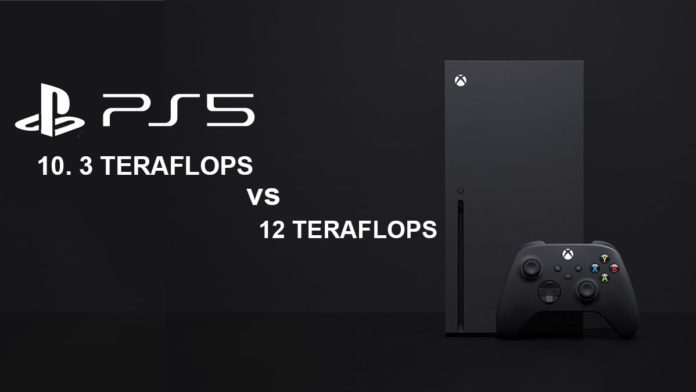
Sony and Microsoft have both revealed their upcoming next-gen gaming consoles – the PS5 and the Xbox Series X. The latter has been confirmed to include a GPU with 12 Teraflops of power. But now, after Sony’s PS5 spec reveal, we now know that the PlayStation console will be housing 10.3 Teraflops of GPU compute power.
Both companies have revealed their GPU’s power unit with a single term – ‘Teraflop’, but what does that even mean? Well, buckle in as we deep dive into the world of graphics processing and try to speculate what lies inside those shiny consoles.
First, a quick textbook definition – A ‘Teraflop’ refers to the computing power of a processor. Divide the word and you’ll have its literal meaning – Tera (10 million) and flop – floating point. So in essence, a processor with 1TF of power means it can calculate 1 trillion floating-point calculations per second.

In general, we’ve got a couple of handy little formulae for calculating a processor’s power in Teraflops and compute units:
- [(GPU SHADER UNITS * GPU CLOCK in MHZ) * 2 ] / 1,000,000 = Power in Teraflops
- Compute Units * 64 = Shader Units
So in order to calculate any GPU power in Teraflops, you’ll need to have 2 numbers – Amount of GPU Shaders and their clock speed. From there, using the above formula, you can calculate the said GPU’s power unit in Teraflops. But why do so? What advantage does knowing the TF unit of a GPU bring us? Well, as you’ve probably guessed, the higher the unit, the better equipped the processor.
Now before we dive down any further, let me remind you that a GPU’s power doesn’t need to be explicitly defined by the number of teraflops it can boast of. Generational leaps in architecture design also play a key role, and that is what the next-gen consoles are taking advantage of. As we know by now, both the Xbox Series X (XSeX?) and PS5 are using AMD’s custom-designed Radeon GPUs, which are based on their latest Navi architecture.

It’s the same architecture that AMD has been using in its latest products in the graphics card division. All the RX 5000 series cards are based on the same architecture and provide a huge benefit in terms of power and efficiency over the previous GCN-based cards.
So now that we have that out of the way, let’s talk about the new consoles. The Xbox Series X has been confirmed to be using a Navi GPU with hardware raytracing support, something that AMD hasn’t even revealed publicly yet in the PC stratosphere. Previously many leaks have pointed to the GPU in XSeX clocking in at 1.8 GHz, suggesting 52 Compute Units. And with the PlayStation 5
| PS5 | Xbox Series X | |
| CPU | 8x Cores @ 3.5 GHz Custom AMD Zen 2 CPU | 8x Cores @ 3.8 GHz Custom AMD Zen 2 CPU |
| GPU | 10.3 TF Custom AMD RDNA 2 at 2.23 GHz | 12 TFLOPS, AMD RDNA 2 at 1.825 GHz |
| Memory (RAM) | 16 GB GDDR6 | 16 GB GDDR6 |
| Storage | 825 GB SSD | 1 TB SSD |
We talk more about the Xbox Series X’s specs here, but there is one thing that needs to be noted. Just pure numbers don’t guarantee performance. When compared to GCN, the RDNA Navi architecture is much more efficient for gaming builds. In theory, you could jack up the clocks on older GPUs to simulate a Series X-like experience, but it really won’t be the same thing.
Recently after Sony’s PS5 system deep dive by Mark Cerny, we saw many gamers voice their concern about the lower TFLop number. But in terms of that console, the real deal is the SSD+RAM implementation. Sony has much faster storage in place, in fact about twice as fast as the Series X. This will indeed help in game development in different ways than what a more powerful GPU will. It kind of makes up for the slightly slower GPU on Sony’s end.
Performance is noticeably different, because ‘teraflops’ is defined as the computational capability of the vector ALU. That’s just one part of the GPU, there are a lot of other units – and those other units all run faster when the GPU frequency is higher. At 33 per cent higher frequency, rasterisation goes 33 per cent faster, processing the command buffer goes that much faster, the L1 and L2 caches have that much higher bandwidth, and so on.
Mark Cerny at the Sony PS5 Reveal
For more information, you can refer here. We’ll have more breakdowns about both consoles soon. Until then, you could read our PS4 vs PS5 comparison, as well as our analysis of ALL Xbox One consoles vs the Xbox Series X.


